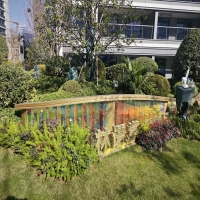Welcome to the website for landscape facilities products and knowledge.
How does the table handle expansion or contraction due to temperature fluctuations without warping?
Temperature fluctuations present a significant challenge to furniture integrity, particularly for tables that must maintain their flat surfaces and structural stability over years of use. The secret to preventing warping lies in sophisticated engineering principles that accommodate wood's natural tendency to expand and contract with changing environmental conditions.
Quality table manufacturers employ several key strategies to combat thermal movement. Expansion joints, also called relief cuts, are deliberate gaps or channels built into the table's structure that allow controlled movement of wood panels. These strategic openings provide necessary space for the wood to expand during humid, warm conditions and contract during dry, cold periods without creating internal stresses that lead to warping.
Material selection plays an equally crucial role. Quarter-sawn lumber, cut radially from the log, demonstrates significantly less dimensional change compared to plain-sawn wood. This cutting method aligns the growth rings perpendicular to the board's width, resulting in more stable pieces that expand and contract primarily in thickness rather than width. Additionally, engineered wood products like plywood and MDF offer enhanced dimensional stability due to their cross-laminated construction that counteracts natural wood movement tendencies.
Advanced construction techniques further enhance thermal resistance. Breadboard ends, traditional woodworking joints where a perpendicular piece attaches to the end of a tabletop, allow longitudinal expansion while maintaining a straight edge. Similarly, slotted fastener holes in table aprons and frames permit horizontal movement while keeping the tabletop securely attached. Modern manufacturers often combine these traditional methods with innovative adhesives specifically formulated to remain flexible after curing, creating bonds that accommodate slight movement without failing.
The orientation of wood grain within the table structure represents another critical consideration. Strategic grain matching across panels ensures uniform expansion patterns, while proper finishing techniques that seal all surfaces equally prevent moisture absorption differentials that cause uneven movement. For tabletops, many craftsmen intentionally leave slight crowns in the wood that counteract potential cupping, creating tables that actually improve in flatness over time.
Through these integrated approaches—combining material science, mechanical engineering, and traditional craftsmanship—quality tables maintain their structural integrity across seasons and climate variations. This thoughtful engineering transforms what could be a vulnerability into a demonstration of durability, ensuring tables remain functional and beautiful despite constant environmental challenges.
Related search:

Recommendation
Metal and acrylic color-changing combined curtain wall for large-scale public landscape facilities